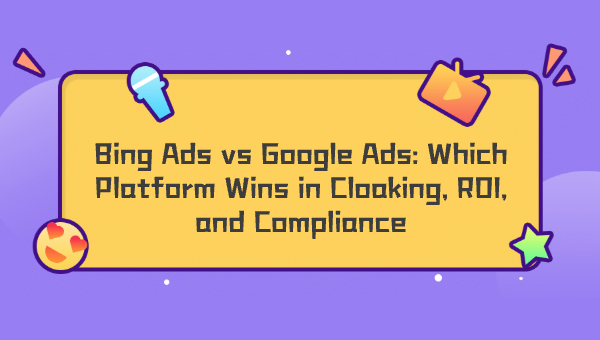Bing Ads vs Google Ads: Which Platform Wins in Cloaking, ROI, and Compliance
If you're running ad campaigns in sensitive or high-ROI verticals, one question becomes critical: Bing Ads vs Google Ads — which is more effective, more lenient, and more Cloaking-friendly? This article compares the two in terms of audience reach, approval policies, risk models, and how well they integrate with cloaking technologies.

1. Audience Size and Search Intent
Google Ads dominates global search with over 90% market share. It's ideal for high-scale growth but comes with high competition and cost.
Bing Ads (Microsoft Ads) controls a smaller slice—around 6–8%, mostly on desktop—yet delivers highly qualified leads, often with lower CPCs.
Bottom line: Google offers massive scale; Bing delivers quieter, cheaper conversions.
2. Review Systems and Risk Management
Google is known for:
Sophisticated bot review systems
Domain reputation scoring
AI-based jump tracking
Frequent manual account audits
Bing, in contrast:
Uses fewer automated crawl bots
Applies less aggressive domain filtering
Is more lenient in grey-hat industries (VPN, supplements, affiliate)
Cloaking Tip: Bing Ads is far easier to test cloaked offers on without getting banned, especially for new accounts.
3. How Each Platform Handles Cloaking
| Feature | Google Ads | Bing Ads |
|---|---|---|
| TDS support needed | Yes (mandatory) | Yes (recommended) |
| Bot traffic frequency | High | Medium |
| Redirection detection strictness | Very strict | Moderate |
| IP filtering essential | Yes | Optional |
If you're using AdCloaking, both platforms are supported—but Bing is better suited for aggressive or early-stage cloaking campaigns.
4. Budget and ROI Differences
On average:
Google CPC: $0.80–$1.50
Bing CPC: $0.30–$0.80
Conversion rates can be similar, but CPA on Bing tends to be lower
Use Bing to test new offers, and move to Google when campaigns are polished and ROI-optimized.
Final Recommendation
Don't put all your traffic in one basket. With the right cloaking system and smart allocation strategy, Bing Ads and Google Ads can work together—one for scale, the other for testing and protection.
Final CTA:
Ready to scale cloaked campaigns across both platforms? Start your 3-day free trial at AdCloaking.com and deploy intelligent cloaking with auto-bot detection, IP filtering, and zero-delay redirects.
